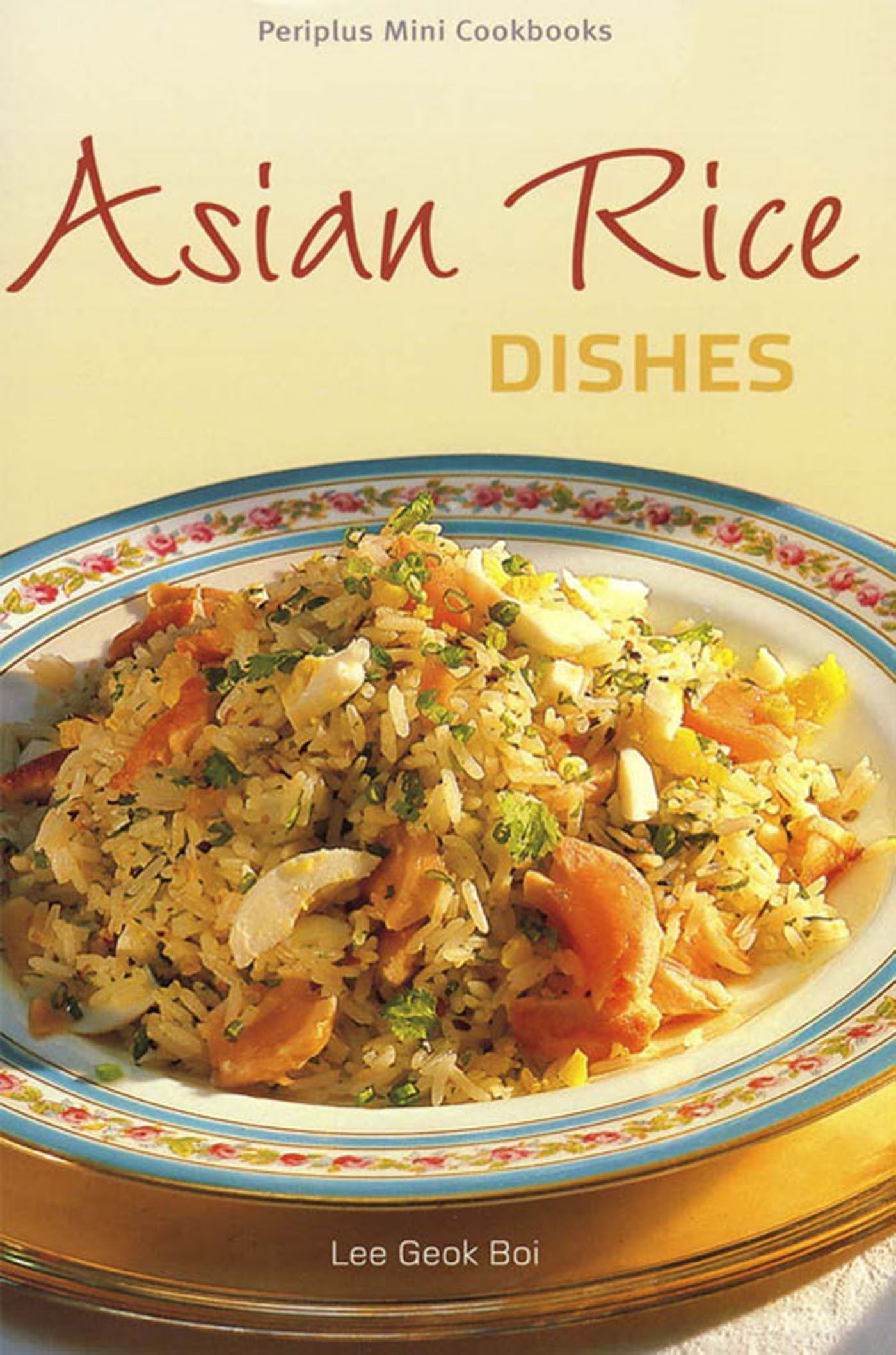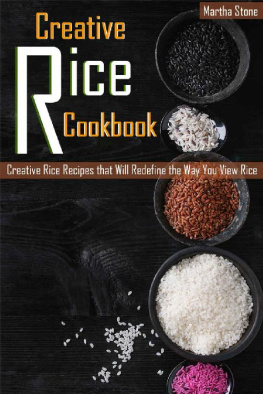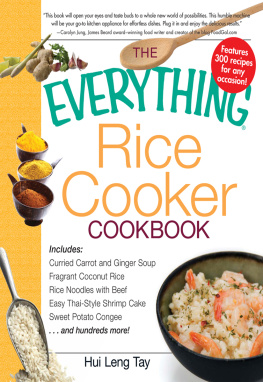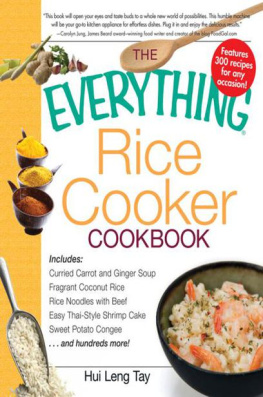Cover

Basic Asian Ingredients
Basmati rice is an Indian long-grain rice characterized by its thinness and fragrance. The grains stay whole and separate when cooked with oil and spices. Substitute with long-grain Thai jasmine rice.
Black Chinese mushrooms, also known as shiitake mushrooms, are used widely in Asian cooking. The dried ones must be soaked in hot water to soften before use, from 15 minutes to an hour, depending on the thickness. The stems are removed and discarded; only the caps are used.
Fresh shiitake mushroom stems can be eaten if the bottoms are trimmed. Brown rice is rice with its golden-brown bran intact. It has more fiber than milled white rice. It also has a nutty texture.  Chilies come in many shapes and sizes. Fresh green and red fingerlength chilies are moderately hot.
Chilies come in many shapes and sizes. Fresh green and red fingerlength chilies are moderately hot.
Tiny red, green or yellow-orange chili padi are very hot. Dried chilies are usually cut into lengths and soaked in warm water to soften before use. Chili powder is made from ground dried chilies. It is a good substitute for dried chilies teaspoon chili powder for 1 dried chili. Coconut milk and grated coconut can be bought fresh from local wet markets. Coconut milk is also available canned and in packets.
They come in varying consistencies and you will need to adjust the thickness by adding water as needed. In general, you should add 1 cup of water to 1 cup of canned or packet coconut cream to obtain thick coconut milk, and 2 cups of water to 1 cup of coconut cream to obtain thin coconut milk. Coriander is an indispensable herb and spice in Asian cooking. Corianderseeds are roasted and then ground in spice pastes. Coriander roots are used in the same way, while coriander leaves (also known as cilantro or Chinese parsley) are used as a herb and a garnish.  Dried shrimp paste or belachan is a dense mixture of fermented ground shrimp that must be toasted before useeither wrapped in foil and dryroasted in a pan over low heat or toasted over an open gas flame.
Dried shrimp paste or belachan is a dense mixture of fermented ground shrimp that must be toasted before useeither wrapped in foil and dryroasted in a pan over low heat or toasted over an open gas flame.
It is sold in dried blocks and ranges in color from light brown to black. It should be slightly toasted to enhance its flavor before using.  Ghee is a rich clarified butter oil with the milk solids removed and is the main oil used in Indian cooking. Substitute with oil or butter. Glutinousrice is very starchy and is often cooked by steaming and used in desserts.
Ghee is a rich clarified butter oil with the milk solids removed and is the main oil used in Indian cooking. Substitute with oil or butter. Glutinousrice is very starchy and is often cooked by steaming and used in desserts.  Jicama (bangkuang) is a crunchy and juicy white tuber that is peeled and eaten raw, sliced and served with rock salt or dressing as a refreshing snack.
Jicama (bangkuang) is a crunchy and juicy white tuber that is peeled and eaten raw, sliced and served with rock salt or dressing as a refreshing snack.
Look for it in the produce section of supermarkets.  Kerupuk are dried crackers made from bits of shrimp, fish, vegetables and nuts mixed with various types of flour to make a very popular snack in Indonesia. They must be thoroughly dried in the sun or in an oven set on very low before deep-frying in very hot oil for a few seconds, when they puff up spectacularly and become crispy. Store fried kerupuk in an airtight container. Oyster sauce is the rich extract of dried oysters and is added to stir-fried meat and vegetable dishes.
Kerupuk are dried crackers made from bits of shrimp, fish, vegetables and nuts mixed with various types of flour to make a very popular snack in Indonesia. They must be thoroughly dried in the sun or in an oven set on very low before deep-frying in very hot oil for a few seconds, when they puff up spectacularly and become crispy. Store fried kerupuk in an airtight container. Oyster sauce is the rich extract of dried oysters and is added to stir-fried meat and vegetable dishes.  Pandanus leaves are long, thin leaves used to impart a delicate fragrance and green hue to cakes and desserts.
Pandanus leaves are long, thin leaves used to impart a delicate fragrance and green hue to cakes and desserts.  Pandanus leaves are long, thin leaves used to impart a delicate fragrance and green hue to cakes and desserts.
Pandanus leaves are long, thin leaves used to impart a delicate fragrance and green hue to cakes and desserts.
Substitute bottled pandanus essence or vanilla essence. Rice vinegar is a mild and fragrant vinegar that is very popular in Asian cooking. You may substitute distilled white vinegar, however reduce the quantity.  Tamarind is the pulp of seedpods from the Tamarind tree and imparts a fruity sourness to dishes. To make tamarind juice, mash about 1 tablespoon of dried tamarind pulp with 2 tablespoons of warm water, squeeze and strain to remove the seeds and fibers. Unpolished red rice is a whole-grain rice which is red in color and comes with a slight mustiness.
Tamarind is the pulp of seedpods from the Tamarind tree and imparts a fruity sourness to dishes. To make tamarind juice, mash about 1 tablespoon of dried tamarind pulp with 2 tablespoons of warm water, squeeze and strain to remove the seeds and fibers. Unpolished red rice is a whole-grain rice which is red in color and comes with a slight mustiness.
It is rich in fiber and nutrients.  Saffron is the world's most expensive spice. The dried strands should be allowed to infuse in warm milk before being added to rice and dessert dishes. Store saffron in the freezer as it loses its fragrance quickly, and never buy powdered saffron if you want the true aroma of this spice. Soy sauce is brewed from soybeans, wheat and salt. Dark soy sauce is denser and less salty, and adds a smoky flavor to sauces and stirfries. Dark soy sauce is denser and less salty, and adds a smoky flavor to sauces and stirfries.
Saffron is the world's most expensive spice. The dried strands should be allowed to infuse in warm milk before being added to rice and dessert dishes. Store saffron in the freezer as it loses its fragrance quickly, and never buy powdered saffron if you want the true aroma of this spice. Soy sauce is brewed from soybeans, wheat and salt. Dark soy sauce is denser and less salty, and adds a smoky flavor to sauces and stirfries. Dark soy sauce is denser and less salty, and adds a smoky flavor to sauces and stirfries.
Available bottled in supermarkets and provision shops.
How to Prepare Various Types of Rice
How To Cook Plain Rice There are three traditional ways of cooking rice:
Method 1: Bring the rice and water to a boil on a stove with the pot three-quarters covered. When the rice is boiling, turn the heat down to low and continue to simmer for another 15 minutes, with the pot partially covered. When the water is all gone, turn off the heat and cover the pot. Leave the rice undisturbed for another 10 minutes.
Method 2: There should be at least three times the amount of water to the rice.
Bring the rice to a boil and let it boil vigorously for 5 minutes. Drain the water, leaving about 60 ml ( cup). Return the rice to a very low fire for another 5 minutes with the pot covered. Turn off the heat and let the rice stand for another 10 minutes. The rice water can be used as a thickener in curries and stews or sweetened and taken as a drink like barley water. Method 3: For glutinous rice, the ratio of rice to water is one cup water to one cup rice. Method 3: For glutinous rice, the ratio of rice to water is one cup water to one cup rice.
The heat-proof container should be at least twice as big as the amount of rice to allow for expansion. Place the container of rice and water in a pot half-filled with water and steam with the pot closed for 20 minutes. Plain glutinous rice is also steamed without water in a close-weave bamboo basket or on a large piece of muslin cloth placed on a rack in a steamer. Stir the rice occasionally. Coconut milk may be stirred in to add flavor and to make the rice softer. Or you can sprinkle water on the rice.













 Chilies come in many shapes and sizes. Fresh green and red fingerlength chilies are moderately hot.
Chilies come in many shapes and sizes. Fresh green and red fingerlength chilies are moderately hot. Dried shrimp paste or belachan is a dense mixture of fermented ground shrimp that must be toasted before useeither wrapped in foil and dryroasted in a pan over low heat or toasted over an open gas flame.
Dried shrimp paste or belachan is a dense mixture of fermented ground shrimp that must be toasted before useeither wrapped in foil and dryroasted in a pan over low heat or toasted over an open gas flame. Ghee is a rich clarified butter oil with the milk solids removed and is the main oil used in Indian cooking. Substitute with oil or butter. Glutinousrice is very starchy and is often cooked by steaming and used in desserts.
Ghee is a rich clarified butter oil with the milk solids removed and is the main oil used in Indian cooking. Substitute with oil or butter. Glutinousrice is very starchy and is often cooked by steaming and used in desserts.  Jicama (bangkuang) is a crunchy and juicy white tuber that is peeled and eaten raw, sliced and served with rock salt or dressing as a refreshing snack.
Jicama (bangkuang) is a crunchy and juicy white tuber that is peeled and eaten raw, sliced and served with rock salt or dressing as a refreshing snack. Kerupuk are dried crackers made from bits of shrimp, fish, vegetables and nuts mixed with various types of flour to make a very popular snack in Indonesia. They must be thoroughly dried in the sun or in an oven set on very low before deep-frying in very hot oil for a few seconds, when they puff up spectacularly and become crispy. Store fried kerupuk in an airtight container. Oyster sauce is the rich extract of dried oysters and is added to stir-fried meat and vegetable dishes.
Kerupuk are dried crackers made from bits of shrimp, fish, vegetables and nuts mixed with various types of flour to make a very popular snack in Indonesia. They must be thoroughly dried in the sun or in an oven set on very low before deep-frying in very hot oil for a few seconds, when they puff up spectacularly and become crispy. Store fried kerupuk in an airtight container. Oyster sauce is the rich extract of dried oysters and is added to stir-fried meat and vegetable dishes.  Pandanus leaves are long, thin leaves used to impart a delicate fragrance and green hue to cakes and desserts.
Pandanus leaves are long, thin leaves used to impart a delicate fragrance and green hue to cakes and desserts.  Tamarind is the pulp of seedpods from the Tamarind tree and imparts a fruity sourness to dishes. To make tamarind juice, mash about 1 tablespoon of dried tamarind pulp with 2 tablespoons of warm water, squeeze and strain to remove the seeds and fibers. Unpolished red rice is a whole-grain rice which is red in color and comes with a slight mustiness.
Tamarind is the pulp of seedpods from the Tamarind tree and imparts a fruity sourness to dishes. To make tamarind juice, mash about 1 tablespoon of dried tamarind pulp with 2 tablespoons of warm water, squeeze and strain to remove the seeds and fibers. Unpolished red rice is a whole-grain rice which is red in color and comes with a slight mustiness. Saffron is the world's most expensive spice. The dried strands should be allowed to infuse in warm milk before being added to rice and dessert dishes. Store saffron in the freezer as it loses its fragrance quickly, and never buy powdered saffron if you want the true aroma of this spice. Soy sauce is brewed from soybeans, wheat and salt. Dark soy sauce is denser and less salty, and adds a smoky flavor to sauces and stirfries. Dark soy sauce is denser and less salty, and adds a smoky flavor to sauces and stirfries.
Saffron is the world's most expensive spice. The dried strands should be allowed to infuse in warm milk before being added to rice and dessert dishes. Store saffron in the freezer as it loses its fragrance quickly, and never buy powdered saffron if you want the true aroma of this spice. Soy sauce is brewed from soybeans, wheat and salt. Dark soy sauce is denser and less salty, and adds a smoky flavor to sauces and stirfries. Dark soy sauce is denser and less salty, and adds a smoky flavor to sauces and stirfries.